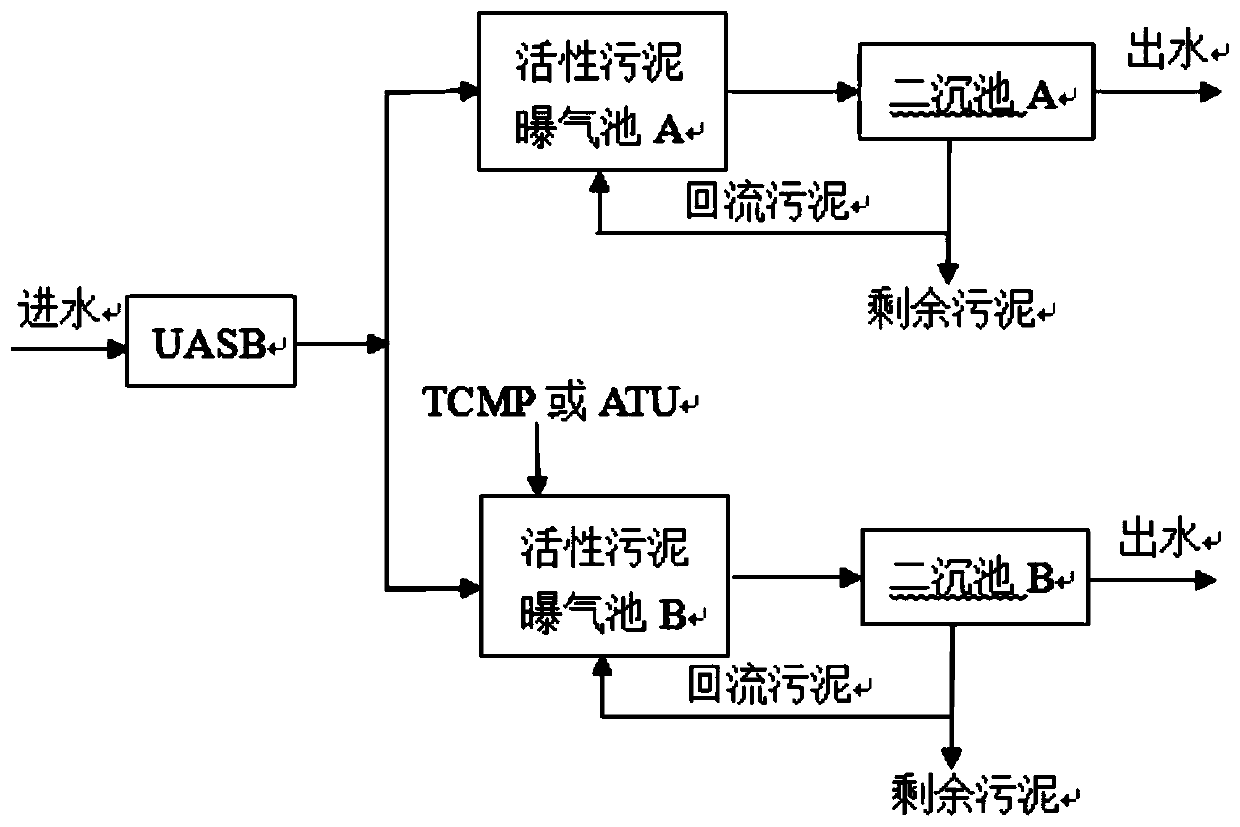Method for retaining ammonia nitrogen and removing antibiotics in biological treatment process of livestock and poultry breeding sewage
A sewage biological treatment, livestock and poultry breeding technology, applied in the field of sewage treatment, can solve the problems of ammonia nitrogen nitrification, nitrogen loss, etc., to achieve the effect of removing antibiotics, retaining ammonia nitrogen, and inhibiting ammonia nitrogen nitrification
- Summary
- Abstract
- Description
- Claims
- Application Information
AI Technical Summary
Problems solved by technology
Method used
Image
Examples
Embodiment 1
[0018] Embodiment 1. Adopt figure 1 The process shown is anaerobic-aerobic biochemical treatment of sewage from a pig farm in Jinshan District, Shanghai
[0019] figure 1 HRT of medium UASB=3d, MLSS=15±1g / L, pH=7.5±0.5;
[0020] Aerobic pool A: HRT=3d, SRT=40d, MLSS=4500±500mg / L, pH=8.0±0.5, dissolved oxygen concentration DO=3.0±0.5mg / L;
[0021] Aerobic pool B: HRT=3d, SRT=40d, MLSS=4500±500mg / L, pH=8.0±0.5, dissolved oxygen concentration DO=3.0±0.5mg / L, TCMP dosage is 3.0mg / g VSS· d.
[0022] The average concentrations of COD and ammonia nitrogen in the influent are 5610mg / L and 835mg / L, respectively. After the anaerobic-aerobic biochemical treatment system runs stably, the average concentrations of COD and ammonia nitrogen in the secondary sedimentation tank A are 247mg / L and 7.3mg / L respectively. L. Therefore, when no TCMP is added to the aeration tank, the average removal rate of COD is about 95.6%, and the average removal (or nitrification) rate of ammonia nitrogen ...
Embodiment 2
[0026] The sewage treatment process, sewage source, operating conditions, etc. of Example 2 are the same as those of Example 1, the only difference is that the TCMP added to the aeration tank B in Example 1 is replaced by ATU, and the dosage is 15mg / g VSS·d.
[0027] The average concentrations of COD and ammonia nitrogen in the influent are 5382mg / L and 792mg / L respectively. After the anaerobic-aerobic biochemical treatment system runs stably, the average concentrations of COD and ammonia nitrogen in the secondary sedimentation tank A are 286mg / L and 10.3mg / L respectively. L. Therefore, when no ATU is added to the aeration tank, the average removal rate of COD is about 94.5%, and the average nitrification rate of ammonia nitrogen is 98.7%. The average concentrations of COD and ammonia nitrogen in the effluent of secondary sedimentation tank B are 430mg / L and 652mg / L respectively, so when ATU is added to the aeration tank, the average removal rate of COD is about 92.0%, and th...
PUM
 Login to view more
Login to view more Abstract
Description
Claims
Application Information
 Login to view more
Login to view more - R&D Engineer
- R&D Manager
- IP Professional
- Industry Leading Data Capabilities
- Powerful AI technology
- Patent DNA Extraction
Browse by: Latest US Patents, China's latest patents, Technical Efficacy Thesaurus, Application Domain, Technology Topic.
© 2024 PatSnap. All rights reserved.Legal|Privacy policy|Modern Slavery Act Transparency Statement|Sitemap

